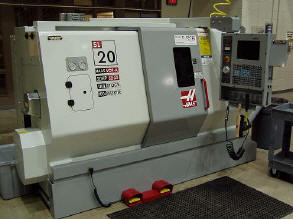CAM: Computer Aided Manufacturing
Definition: Computer-Aided Manufacturing (CAM) is the use of computer software and hardware in the translation of
computer-aided design models into manufacturing instructions for numerical controlled machine tools.
Applications of Computer-Aided Manufacturing
The field of
computer-aided design has steadily advanced over the past four decades to the stage
at which conceptual designs for new products can be made entirely within the framework of CAD
software. From the development of the basic design to the Bill of Materials necessary to
manufacture the product there is no requirement at any stage of the process to build physical prototypes.
Computer-Aided Manufacturing takes this one step further by bridging the gap between the
conceptual design and the manufacturing of the finished product. Whereas in the past it
would be necessary for a design developed using CAD software to be manually converted
into a drafted paper drawing detailing instructions for its manufacture, Computer-Aided
Manufacturing software allows data from CAD software to be converted directly into a set
of manufacturing instructions.
 CAM software converts 3D models generated in CAD into a set of basic operating
instructions written in G-Code. G-code is a programming language that can be understood
by numerical controlled machine tools – essentially industrial robots – and the G-code can
instruct the machine tool to manufacture a large number of items with perfect precision and
faith to the CAD design. CAM software converts 3D models generated in CAD into a set of basic operating
instructions written in G-Code. G-code is a programming language that can be understood
by numerical controlled machine tools – essentially industrial robots – and the G-code can
instruct the machine tool to manufacture a large number of items with perfect precision and
faith to the CAD design.
Modern numerical controlled machine tools can be linked into a ‘cell’, a collection of tools
that each performs a specified task in the manufacture of a product. The product is passed
along the cell in the manner of a production line, with each machine tool (i.e. welding and
milling machines, drills, lathes etc.) performing a single step of the process.
For the sake of convenience, a single computer ‘controller’ can drive all of the tools in a
single cell. G-code instructions can be fed to this controller and then left to run the cell
with minimal input from human supervisors.
Benefits of Computer-Aided Manufacturing
While undesirable for factory workers, the ideal state of affairs for manufacturers is an
entirely automated manufacturing process. In conjunction with computer-aided design,
computer-aided manufacturing enables manufacturers to reduce the costs of producing goods
by minimising the involvement of human operators.
In addition to lower running costs there are several additional benefits to using CAM software.
By removing the need to translate CAD models into manufacturing instructions through paper drafts
it enables manufactures to make quick alterations to the product design, feeding updated
instructions to the machine tools and seeing instant results.
In addition, many CAM software packages have the ability to manage simple tasks such as the
re-ordering of parts, further minimising human involvement. Though all numerical controlled
machine tools have the ability to sense errors and automatically shut down, many can actually
send a message to their human operators via mobile phones or e-mail, informing them of the
problem and awaiting further instructions.
All in all, CAM software represents a continuation of the trend to make manufacturing entirely
automated. While CAD removed the need to retain a team of drafters to design new products, CAM
removes the need for skilled and unskilled factory workers. All of these developments result in
lower operational costs, lower end product prices and increased profits for manufacturers.
Problems with Computer-Aided Manufacturing
Unfortunately, there are several limitations of computer-aided manufacturing. Obviously,
setting up the
infrastructure to begin with can be extremely expensive. Computer-aided
manufacturing requires not only the numerical controlled machine tools themselves but also
an extensive suite of CAD/CAM software and hardware to develop the design models and convert
them into manufacturing instructions – as well as trained operatives to run them.
Additionally, the field of computer-aided management is fraught with inconsistency. While
all numerical controlled machine tools operate using G-code, there is no universally used
standard for the code itself. Since there is such a wide variety of machine tools that use
the code it tends to be the case that manufacturers create their own bespoke codes to
operate their machinery.
While this lack of standardisation may not be a problem in itself, it can become a problem
when the time comes to convert 3D CAD designs into G-code. CAD systems tend to store data
in their own proprietary format (in the same way that word processor applications do), so
it can often be a challenge to transfer data from CAD to CAM software and then into whatever
form of G-code the manufacturer employs.
Further information regarding computer-aided manufacturing can be found at the
Berkeley CAM
Research site, UC Irvine’s CAM resource site and the National Institute of Standards and
Technology (NIST) (PDF).
|
 CAM software converts 3D models generated in CAD into a set of basic operating
instructions written in G-Code. G-code is a programming language that can be understood
by numerical controlled machine tools – essentially industrial robots – and the G-code can
instruct the machine tool to manufacture a large number of items with perfect precision and
faith to the CAD design.
CAM software converts 3D models generated in CAD into a set of basic operating
instructions written in G-Code. G-code is a programming language that can be understood
by numerical controlled machine tools – essentially industrial robots – and the G-code can
instruct the machine tool to manufacture a large number of items with perfect precision and
faith to the CAD design.